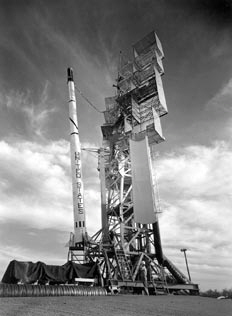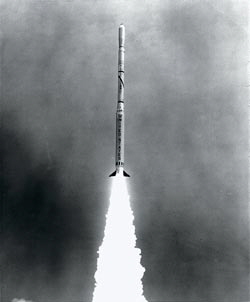|
Sequencing the Flight Events
 An electro-explosive device (EED) started the ignition of each solid-propellant rocket motor. An EED contained an electrically resistive element (a bridgewire) which heated up when an electrical current was applied to it. The hot bridgewire set off an explosive charge within the device. The explosive charge in turn set off an igniter, which sent a flame down the hollow core of the rocket motor to ignite the propellant. EEDís were also used in electro-explosive actuators, where the explosive force would move a mechanical lever, and in explosive bolts where the explosive force would break the bolt allowing parts to separate. An electro-explosive device (EED) started the ignition of each solid-propellant rocket motor. An EED contained an electrically resistive element (a bridgewire) which heated up when an electrical current was applied to it. The hot bridgewire set off an explosive charge within the device. The explosive charge in turn set off an igniter, which sent a flame down the hollow core of the rocket motor to ignite the propellant. EEDís were also used in electro-explosive actuators, where the explosive force would move a mechanical lever, and in explosive bolts where the explosive force would break the bolt allowing parts to separate.
The first-stage motor of Scout was fired by a signal from the ground. All other pyrotechnic events during the flight were initiated by preset commands from the guidance system, which closed electromechanical relays and applied firing current to the EEDís. Second-stage ignition was commanded after the first stage burned out and after the atmosphere was thin enough that air pressure on the vehicle would not interfere with the control of the vehicle by the reaction control motors. After burnout of the second stage the altitude was high enough that the heat shield was no longer required to protect the payload from aerodynamic heating. EEDís in the heat shield fired an electro-explosive actuator, which mechanically released locks and ejected the heat shield.  Shortly after heat shield ejection, the third stage motor was ignited. After burnout of the third stage, the vehicle was allowed to coast for 200 to 600 seconds before the fourth-stage motor was spun up and fired. One set of guidance system commands initiated both spin-motor and fourth-stage motor ignition. The fourth-stage motor EED had a 4.5-second delay fuse train to allow spin up and stage separation before the fourth stage ignited. One second after the guidance system issued the spin motor and fourth-stage ignition signal, it commanded fourth-stage separation. Separation was achieved by firing explosive bolts, which released a clamp holding the third and fourth stages together. When the clamp was released, springs forced the fourth stage away from the third stage. At the same time, the guidance system turned on slightly forward-facing reaction control motors on the third stage, which backed the third stage away from the fourth stage. After fourth stage separation the guidance system no longer had control, because its components were located in the third stage. When it was necessary to separate the payload (spacecraft) from the expended fourth-stage motor, a payload separation system was provided. This system contained batteries and timers that fired explosive bolts in the clamp holding the spacecraft to the fourth-stage motor. Springs pushed the payload away from the fourth stage motor when the clamp was released. The preset payload separation timers were started by switches which were turned on when the clamp holding the third and fourth stages together was released. Shortly after heat shield ejection, the third stage motor was ignited. After burnout of the third stage, the vehicle was allowed to coast for 200 to 600 seconds before the fourth-stage motor was spun up and fired. One set of guidance system commands initiated both spin-motor and fourth-stage motor ignition. The fourth-stage motor EED had a 4.5-second delay fuse train to allow spin up and stage separation before the fourth stage ignited. One second after the guidance system issued the spin motor and fourth-stage ignition signal, it commanded fourth-stage separation. Separation was achieved by firing explosive bolts, which released a clamp holding the third and fourth stages together. When the clamp was released, springs forced the fourth stage away from the third stage. At the same time, the guidance system turned on slightly forward-facing reaction control motors on the third stage, which backed the third stage away from the fourth stage. After fourth stage separation the guidance system no longer had control, because its components were located in the third stage. When it was necessary to separate the payload (spacecraft) from the expended fourth-stage motor, a payload separation system was provided. This system contained batteries and timers that fired explosive bolts in the clamp holding the spacecraft to the fourth-stage motor. Springs pushed the payload away from the fourth stage motor when the clamp was released. The preset payload separation timers were started by switches which were turned on when the clamp holding the third and fourth stages together was released.
SCOUT LAUNCH VEHICLE DESCRIPTION
Motors and Structure
Flight Control
Sequencing the Flight Events
Stage Separation
Destruct System and Radar Beacon Command Destruct
Electrical Power
Launch History
Launch List
|

 An electro-explosive device (EED) started the ignition of each solid-propellant rocket motor. An EED contained an electrically resistive element (a bridgewire) which heated up when an electrical current was applied to it. The hot bridgewire set off an explosive charge within the device. The explosive charge in turn set off an igniter, which sent a flame down the hollow core of the rocket motor to ignite the propellant. EEDís were also used in electro-explosive actuators, where the explosive force would move a mechanical lever, and in explosive bolts where the explosive force would break the bolt allowing parts to separate.
An electro-explosive device (EED) started the ignition of each solid-propellant rocket motor. An EED contained an electrically resistive element (a bridgewire) which heated up when an electrical current was applied to it. The hot bridgewire set off an explosive charge within the device. The explosive charge in turn set off an igniter, which sent a flame down the hollow core of the rocket motor to ignite the propellant. EEDís were also used in electro-explosive actuators, where the explosive force would move a mechanical lever, and in explosive bolts where the explosive force would break the bolt allowing parts to separate.
 Shortly after heat shield ejection, the third stage motor was ignited. After burnout of the third stage, the vehicle was allowed to coast for 200 to 600 seconds before the fourth-stage motor was spun up and fired. One set of guidance system commands initiated both spin-motor and fourth-stage motor ignition. The fourth-stage motor EED had a 4.5-second delay fuse train to allow spin up and stage separation before the fourth stage ignited. One second after the guidance system issued the spin motor and fourth-stage ignition signal, it commanded fourth-stage separation. Separation was achieved by firing explosive bolts, which released a clamp holding the third and fourth stages together. When the clamp was released, springs forced the fourth stage away from the third stage. At the same time, the guidance system turned on slightly forward-facing reaction control motors on the third stage, which backed the third stage away from the fourth stage. After fourth stage separation the guidance system no longer had control, because its components were located in the third stage. When it was necessary to separate the payload (spacecraft) from the expended fourth-stage motor, a payload separation system was provided. This system contained batteries and timers that fired explosive bolts in the clamp holding the spacecraft to the fourth-stage motor. Springs pushed the payload away from the fourth stage motor when the clamp was released. The preset payload separation timers were started by switches which were turned on when the clamp holding the third and fourth stages together was released.
Shortly after heat shield ejection, the third stage motor was ignited. After burnout of the third stage, the vehicle was allowed to coast for 200 to 600 seconds before the fourth-stage motor was spun up and fired. One set of guidance system commands initiated both spin-motor and fourth-stage motor ignition. The fourth-stage motor EED had a 4.5-second delay fuse train to allow spin up and stage separation before the fourth stage ignited. One second after the guidance system issued the spin motor and fourth-stage ignition signal, it commanded fourth-stage separation. Separation was achieved by firing explosive bolts, which released a clamp holding the third and fourth stages together. When the clamp was released, springs forced the fourth stage away from the third stage. At the same time, the guidance system turned on slightly forward-facing reaction control motors on the third stage, which backed the third stage away from the fourth stage. After fourth stage separation the guidance system no longer had control, because its components were located in the third stage. When it was necessary to separate the payload (spacecraft) from the expended fourth-stage motor, a payload separation system was provided. This system contained batteries and timers that fired explosive bolts in the clamp holding the spacecraft to the fourth-stage motor. Springs pushed the payload away from the fourth stage motor when the clamp was released. The preset payload separation timers were started by switches which were turned on when the clamp holding the third and fourth stages together was released.